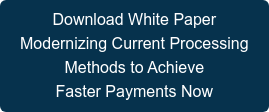
For the financial services sector, it is perhaps the ultimate and not-so-amusing irony that the drive towards faster payments has seemingly moved at a snail’s pace. There is good news, though, as the Federal Reserve’s Faster Payments Task Force has finally finished its work and issued recommendations after some 120,000 labor hours. Meanwhile, the technology to support and deliver faster payments is reaching critical mass, moving us close to the reality of real-time payments.
Yet is it enough to hope that old systems can somehow keep up? Such a non-starting strategy will leave financial institutions exactly where they were before the payments revolution began—sacrificing faster payments to remain in the past of payments.
To be sure, change seldom makes the list of most desired business activities. That noted, today’s payment processes—specifically check positive pay, ACH positive pay, wire transfers and EDI translation—are ripe for easy-to-implement improvements that also improve fraud protection. Here’s a quick look at today’s payments systems and processes, ripe for savvy changes to deliver new levels of performance:
Check positive pay is an automated fraud detection tool financial institutions offer their business customers. It matches the account number, check number and dollar amount of each check presented for payment against a list of checks (literally, a check list) that the business customer previously authorized and issued. If the three components do not match exactly, the check won’t be paid.
Yet some of the largest financial institutions in the U.S. use as many as three different data systems and rooms full of operators to perform clean-up functions before delivering positive pay services to their clients.
For check positive pay services to be truly effective, payee positive pay must be part of the positive pay suite of services. For the past ten years, checks have consistently ranked as the payment instrument most vulnerable to attempted and actual fraud in the 2018 AFP Payments Fraud and Control survey. Payee positive pay is an essential tool for fighting check fraud.
Automated clearing house (ACH) positive pay prevents fraud by allowing business account holders to see all incoming ACH transactions as they arrive and set up trusted trading partners. The most effective ACH positive pay services are completely automated and require no bank intervention. ACH positive pay can be quite costly in terms of labor and effort as the bank has to set up filters for the customer and manually enter returns and offsets to customer accounts.
Not surprisingly, manual work undermines the profitability of check and ACH positive pay services. Manual methods require a room full of operators to print paper, access images or manage filters and blocks, handle disputes, and make corrections.
Wire Transfers are another popular payment option for business account holders, but pose a danger in terms of fraud. In fact, the 2018 AFP survey found that wire fraud contributed to 48 percent of total fraudulent transactions last year. Financial institutions process thousands of transactions each day, which makes wire transfers a prime target for criminals.
It is possible to mitigate wire fraud for online transfers through call-backs to confirm the transactions with customers. But that’s not exactly a boon for faster payments, as call-backs cause the processing of wires—otherwise immediate—to take hours. What’s more, the practice disrupts the account holder’s experience and causes operational inefficiencies that financial institutions could do without.
Electronic Data Interchange (EDI) translation enables companies to send business information back and forth electronically rather than with paper. Here it’s important to note that EDI is a data format, which can not only accommodate payment and related processes but machine-to-machine exchanges of data and messages as well.
With several EDI standards in use today and each with different versions, businesses in communication must agree on how to connect, according to the EDI Basics website. Thus, most businesses send their data through an EDI translator, typically an in-house software or EDI service provider, which allows their internal applications to process data and documents straight through. Once that’s done, the data can be transmitted to the institution or business partner via direct connection (using AS2 or another secure protocol), EDI network provider or a combination.
Though standing in contrast to each other, each of these methods can benefit from a smart technology solution. In our next blog, we’ll explore three solutions for faster payments and better processing.
For more information, download our new white paper, "Modernizing Current Processing Methods to Achieve Faster Payments Now."




